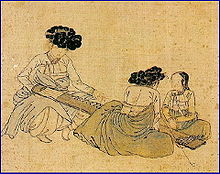Geomungo
| Geomungo | |
 |
|
| Korean name | |
|---|---|
| Hangul | or |
| Hanja | (none) or |
| Revised Romanization | geomun(-)go or hyeon(-)geum |
| McCune–Reischauer | kŏmun'go or hyŏn'gŭm |
The geomungo (also spelled komungo or kŏmun'go) or hyeongeum (literally "black zither", also spelled hyongum or hyŏn'gŭm) is a traditional Korean stringed musical instrument of the zither family of instruments with both bridges and frets. Scholars believe that the name refers to Goguryeo and translates to "Goguryeo zither" or that it refers to the colour and translates to "black crane zither" (hyeonhakgeum, / ).
The instrument originated circa the 4th century (see Anak Tomb No.3 infra) through the 7th century from the kingdom of Goguryeo, the northernmost of the Three Kingdoms of Korea, although the instrument can be traced back to the 4th century.
According to the Samguk Sagi (Chronicles of the Three Kingdoms), written in 1145, the geomungo was invented by prime minister Wang San-ak by using the form of the ancient Chinese instrument guqin (also called chilhyeongeum, literally "seven-string zither"). After his death, the instrument was passed down to Ok Bogo, Son Myeong-deuk, Gwi Geum, An Jang, Cheong Jang, and Geuk Jong, while being widely spread over the kingdom.
Archetype of the instrument is painted in Goguryeo tombs. They are found in the tomb of Muyongchong and Anak Tomb No.3.
The geomungo is approximately 162 cm long and 23 cm wide (63.75 inches long, 9 inches wide), and has movable bridges called Anjok and 16 convex frets. It has a hollow body where the front plate of the instrument is made of paulownia wood and the back plate is made of hard chestnut wood. Its six strings, which are made of twisted silk passed through its back plate. The pick is made from bamboo sticks in the size of regular household pencil. Three strings are directly over the frets which can be stopped whilst the other three are open strings.
...
Wikipedia
